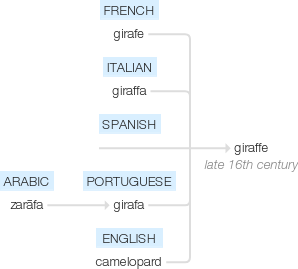Giraffe
late 16th century: from French girafe, Italian giraffa, or Spanish and Portuguese girafa, based on Arabic zarāfa . The animal was known in Europe in the medieval period, and isolated instances of names for it based on the Arabic are recorded in Middle English, when it was commonly called the camelopard.
wiktionary
From French giraffe (now girafe), from Arabic زَرَافَة (zarāfa, “giraffe”); ultimately from Persian زُرنَاپَا (zurnāpā), a compound of زُرنَا (zurnā, “flute”) and پَا (pā, “leg”).
etymonline
giraffe (n.)
long-necked ruminant animal of Africa, 1590s, giraffa, from Italian giraffa, from Arabic zarafa, probably from an African language. Earlier Middle English spellings varied wildly, depending on the foreign source, and included jarraf, ziraph, and gerfauntz, some apparently directly from Arabic, the last reflecting some confusion with olifaunt "elephant."
In Arabye, þei ben clept Gerfauntz; þat is a best pomelee or spotted .. but a lityll more high þan is a stede, But he hath the necke a xxti cubytes long. [Mandeville's Travels, c. 1425]
The modern form of the English word is attested by c. 1600 and is via French girafe (13c.). Replaced earlier camelopard (from Latin camelopardalis), which was the basis form the name of the "giraffe" constellation Camelopardalis, among those added to the map 1590s by Flemish cartographer Petrus Plancius.
